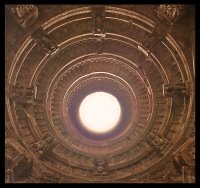Temple of baths unlimited
Temple of a million hopes
Temple of over 4000 pillars
Temple of 22 sacred wells
Temple of the 9 grahas(navagrahas)
Temple of 3 prakarams
Temple of 3 Shiva Lingas
To worship just 1 Lord - Shiva
Rameshwaram: An island off the Tamil Nadu coast
Pamban bridge, is a name so familiar and yet a feeling of fear came in when I remembered what my mother had told me, "Its a low bridge over the sea and scary when you see the lashing waters of the waves in turmoil just dashing against the old bridge as the train moves on swaying with the wind, towards the coast of Rameshwaram."
This is a beautiful sight, to see a vast expanse of water below my feet as I stood at the door feeding my eyes with the early morning sunlight reflecting over its waters. This had to be Pamban and it fitted the description perfectly. The early morning sun colored the blue sky orange and my heart felt light for I had finally made it to Rameshwaram!
Its a small town, smelling of fish everywhere, with no waves for the sea God was cursed by Lord Rama for having destroyed the Navagriha while he worshipped them. Lord Rama had cursed, "there shall be no waves here" and sure enough there are none. A sleepy little town that lives around the temple, where its not too strange to see people walking around dripping wet for its the land that promises you the longest shower, a shower that doesn't clean your body but cleanses your soul!
I started first with well water; being told it was important before I made it to the sea. Soon I descended into the sea, wading through the water to do my prayers there for an hour taking 3 dips in the water before and after my recital of assigned mantras. I walked back towards the temple, to be told my shower has just about begun.
With an old man leading the way holding a bucket and rope in his hand, I walked on, from pillar to wells through a wet labyrinth of halls. I stopped at various points within the temple complex to get a view of the rising sun, having my vision covered with a sheet of silvery water just pouring down my head. A sheet of water, often sweet, often salty and sometimes in between, a sheet of water crystal clear with the sun locked in every drop!
The temple floor has never been dry, with people trooping in for a complete shower. It is an open bath, with pure well water washing away my past karmas. A bath I should not wash away with a regular bath later.
“Yahi hamaaraa samskar hai, we should follow our sampradayam.”
 Devipattinam, Mainland India, 1 hour from Rameshwaram:
Devipattinam, Mainland India, 1 hour from Rameshwaram:Having had my cosmic bath, I moved on to Devipattinam, a place so silent and hosting my ticket to a better life. The Navagraha are 9 rocks of various sizes that stand out of seawater occasionally disappearing with the tide. I descended into the water thanking God for the grainy sandy floor, for I really didn’t want to know what else lived among these waters.
"Vettalai paaku, pazham and sarpam" - beetle leaf with bananas and a silver snake, was an offering of fruit I made to the Navagriha, also hoping for assistance to know where Rahu was, and the curious people of Devipattinam are most willing to help with that. These are not temple sculptures; they are large chunks of rock in water, with peculiar shapes expecting you to know them before you show up. Having placed the "sarpa" at Rahu, I circum-ambulated the navagriha in the water, leaving no room for doubt. I stood in the water, looked at the sun and recited my sankalpa:
My salutations to the Navagriha - to Rahu, ketu, Shani, Surya, Chandra, Shukra...and I cant remember the rest - all this in Sanskrit.
My last deed of the day before I caught the afternoon train back to Chennai was to visit Lord Shiva's shrine. I went straight to a beautifully lit up sanctum, with plenty of oil lamps. Deep within is a Shiva linga, mythologically placed there by Sita, originally made out of sand and called Ramalinga or Rameshwara, while Hanuman was sent to Kailasa for a Shiva Linga and didn’t make it in time for the muhurtham. It is a strong Linga, which Hanuman could not uproot, when he was upset that Lord Rama didn’t wait for his return. A potent Linga that would save Lord Rama from any curse, an eventuality of the death of so many people including Ravana in the great war of the Ramayana, a ritual advised by Sage Agastiyar to Rama to be performed, and hence the temple, that hosts it much later in time.
Among the various shrines that Rameshwaram temple hosts are also two other Lingas that were brought by Hanuman and eventually installed and worshipped here as well known as the Visvalinga, for which abhishekam is done well before the main shrine hosting Sita's Linga is worshipped. Rameshwaram relives the events of the Ramayana bringing every aspect of it to life. It’s an endless list of myths and legends starting with a cosmic shower from 22 wells each of which tasted so different.
A disgusted Brahmin priest once said:
Science wale bolte hein ye artisan well hai. Ab hum kya bolein?













